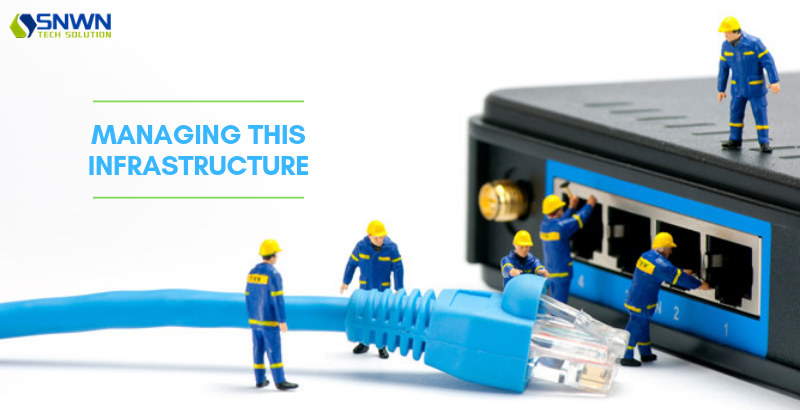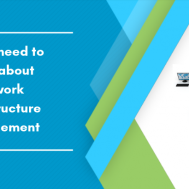Network Infrastructure refers to the medium and its components, across which data flows from physical cabling and logical topologies to network devices and services. But it won’t be functional without efficient management. Hence comes the term Network Infrastructure Management in the picture. In this blog, we will go through an overview of the whole concept from its components to its management.
Network Infrastructure
The hardware and software resources of an entire network create its Network Infrastructure. These resources enable the connectivity, communication, and operations as well as its management, of an enterprise network. It functions by providing a communication path and services between users, applications between users, applications and processes, and external networks (i.e., the internet).
Components:
The various components of the entire network infrastructure are interconnected and facilitate internal and external communications, each at a time, or both simultaneously. The typical network infrastructure includes:
1. Networking Hardware consisting of:
Wired and wireless routers,
Switches,
LAN Cards,
Cables, etc.
2. Networking Software includes:
Network operations and management,
Network security applications,
Operating System(s) for running the applications
Firewall protecting the OS.
Networking Services like:
Satellite and Wireless protocols,
T-1 Line and DSL,
IP Addressing, etc.
How is it different from IT Infrastructure?
Network Infrastructure is by design, a part of IT Infrastructure at an enterprise level. It opens up a communication path between its internal systems as well as external ones that use that infrastructure to access flowing across it. However, in a broader sense, it is a subset of IT infrastructure, which deals with more than one network infrastructure.
In the corporate world, IT infrastructure is critical for the successful business of a company, but the network infrastructure being its part is equally if not more, critical for its overall success.
Also, the IT infrastructure consists of both similar and different resources:
IT Hardware adds a few such as:
Servers,
Computers,
Routers and switches,
Hubs and data-centers, etc.
IT Softwares differs in essence as well:
Customer relationship management (CRM)
Enterprise resource planning (ERP)
Productivity and data management applications, etc.
Human Resources like:
Graphics and UI designers,
Developers,
Business analysts,
HR managers,
Software documentation and,
IT specialists and support.

Managing this infrastructure
Effective management is required for operating the network infrastructure efficiently of an organization. An efficient centralized authority is very important. Here we have tried to look at how you can manage your enterprise network more effectively.
Create an inventory of your systems.
First of all, create an inventory of your existing systems; both functional and not (if any). Let’s call this your critical infrastructure list. There are many ways to do this; you can go walking around and documenting your installing
Develop a change control process.
The next step after documenting all the important systems on your network is to develop a sensible change control process for your network. More often than not, it is seen that people copy these processes from some previous job, or come up with some menial ones to keep their bosses happy. This is not good management. You should have a log for all changes for each and every system in your inventory along with the names of the operators implementing these changes.
Be updated about your compliance standards.
You will always have to check your compliance standards before you willy-nilly install any network management tools. You have to understand what you need to monitor and for how long you need to do it. PCI, Sarbanes-Oxley, and HIPAA, etc. are some of these tools. You can either do it on the same system(s) or bring in
Keep a map with status icons.
Make sure the system that you pick for managing your network can create maps with status icons. This map should add an icon for every system on your inventory or critical infrastructure list and display it in the area where your support or helpdesk is located. Most systems having this functionality must be capable of supporting multiple
Check dependencies.
Certain systems, within a network are dependent on each other. Say you are monitoring a remote location and a device or system fails (for example the router at that location). This is necessary, but getting a series of alarms hampers work. Some monitoring tools come with a feature that allows them to set dependencies so as to avoid this scenario of a series of alarms.
Setup an efficient alerting system.
An efficient alerting system that tells the person intended for that particular issue must be set up and obviously, be based on the working hours of the IT staff. Most of the businesses don’t have the luxury of a 24-hour support system. Most of the medium-to-large sized businesses have a support desk during the day and an on-call system for out of hours.
The alerting system should be set up in such a manner that it sends the alerts to specific server and application teams during business hours, as well as any and every issue about the critical infrastructure be sent to the out of hours support personnel.
Decide on standards for getting network information.
An alert notifying you about network failure or issue is very important, but it all becomes a moot point if you do not get any additional information about the type of issues or the reason for failure. This information can be obtained with the help of some standard network management protocols like SNMP or WMI.
Avail supplemental data about all your important systems.
Other than, the protocols mentioned above there are some other ways to avail these supplemental data about system and applications. These data are very important for investigating an issue with your network infrastructure:
- Check the logs on your devices and servers for storage space in order to store events over a wide time frame. If it is not so, back up your data
on a regular basis. - Get clear pictures of the network traffic going to and fro the devices on your inventory. Take care of the track connecting to these devices and to the data are being downloaded and uploaded by them.
- You can also log
application-specific information. Which further includesinformation like, what files are being accessed on your file shares, what database queries are being run, what pages are being accessed on your websites, etc.
Don’t forget to perimeter your network.
You can also have an efficient firewall and internet filters in place for protecting your network perimeters. In fact you must keep a lookout on what information is coming in and what is going out of your network infrastructure. Watching traffic flows and implementing an Intrusion Detection System (IDS) can achieve that.
Track systems and users.
Finally, after you have taken appropriate steps for monitoring and alerting in place for all your devices on the critical infrastructure list, what you need to do is identifying where everything is plugged into in your system. There are many ways to track down networking hosts; you can either, do it manually by logging onto your switches and looking at MAC address tables, or you could use supplications for that purpose.
